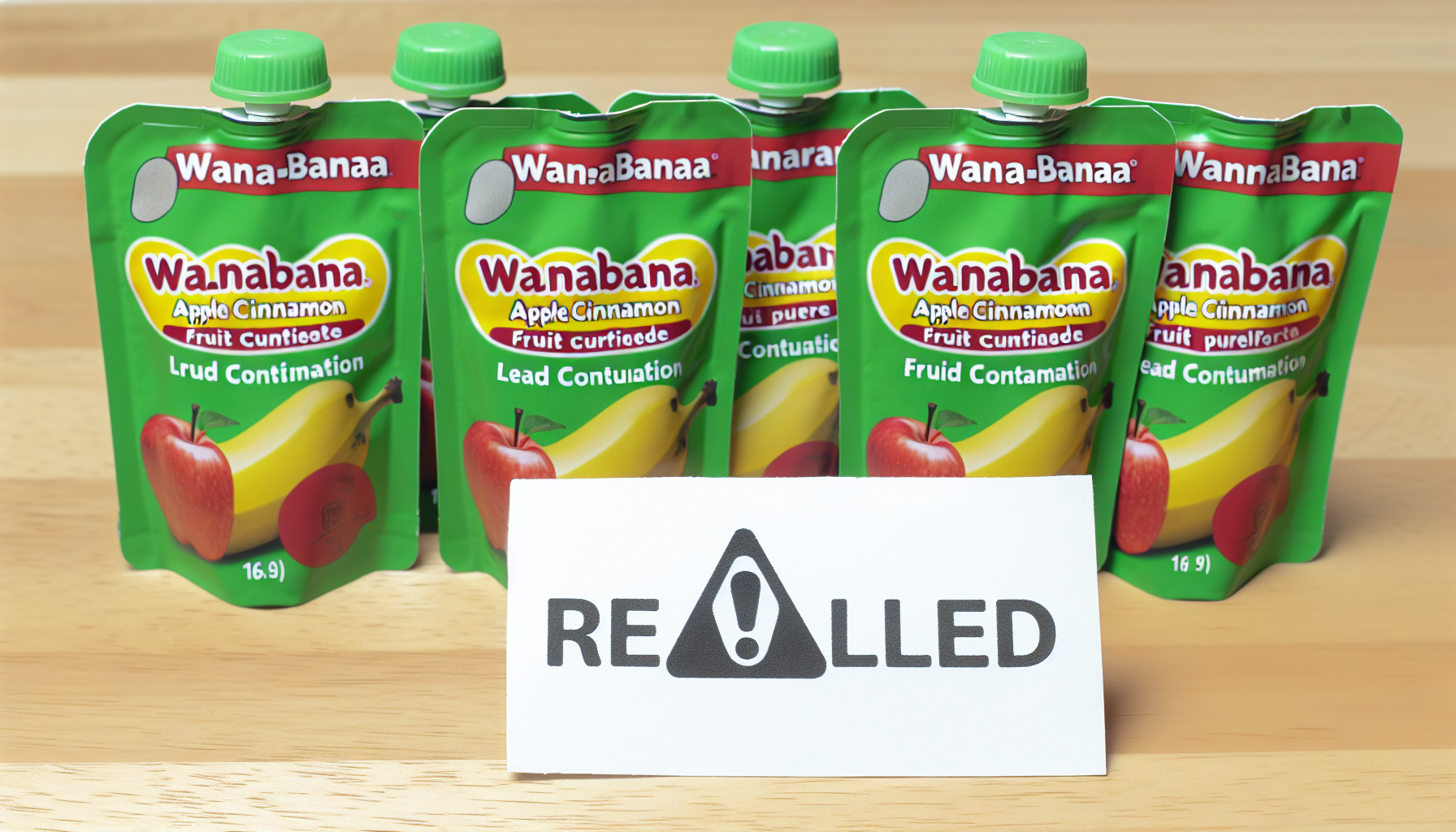Applesauce Lawsuit Escalates: A Deep Dive into the Lead Contamination Scandal
Imagine a world where a simple snack could turn into a ticking time bomb. Shockingly, this is the reality for parents who have discovered that their child’s favorite applesauce pouches, manufactured by WanaBana, have been contaminated with lead. In this post, we’ll unravel the grim truth behind the ongoing applesauce lawsuit, the surprising source of contamination, and the companies’ responses. We’ll also delve into the severe health implications, regulatory oversight, and what parents can do to protect their little ones.
Key Takeaways
- The WanaBana Applesauce Lawsuit is a growing concern, with 118 cases of lead poisoning across 31 states currently under investigation.
- Companies have responded to the scandal by issuing recalls and warnings due to the tainted cinnamon ingredient supplied by Austrofood SAS.
- Parents should be aware of contaminated products and seek medical help if symptoms are present for their children’s safety from lead poisoning.
The WanaBana Applesauce Lawsuit: A Growing Concern

The WanaBana applesauce lawsuit in 2023 serves as a stark reminder of the hidden dangers in our food supply, weaving a tale of shock and dismay. Frighteningly, at least 64 children have been poisoned by the lead-laden applesauce pouches, a number that continues to rise. The symptomless nature of lead poisoning has made it all the more sinister, with many children likely affected without their parents’ knowledge.
Parents, grappling with the grim reality, are seeking justice as the horror unfolds. They have the option to pursue a settlement or financial compensation to address their child’s suffering and the mounting medical costs. This battle is not about money, but about holding those responsible to account and safeguarding our children’s future, which includes working with their child’s healthcare provider and seeking support from human services.
Legal Action Against WanaBana
A lawsuit from a North Carolina family, whose one-year-old daughter was diagnosed with lead poisoning, initially sparked the legal storm brewing against WanaBana. This set the ball rolling for a series of legal actions, as more families affected by the lead contamination in WanaBana’s cinnamon applesauce pouches began to step forward.
Families impacted by the lead contamination retain the right to file a lawsuit against WanaBana. If parents suspect their child has been affected by lead poisoning from WanaBana applesauce, the recommended course of action is to seek legal counsel to potentially initiate legal action.
Affected families can reach out to the Schmidt Firm, PLLC for a complimentary case consultation.
Affected Children and Families

The lead contamination scandal has had a ripple effect, reaching far and wide. A staggering 118 cases across 31 states are currently under investigation for lead poisoning. The Centers for Disease Control and Prevention (CDC) has received reports of 125 cases from 22 different states, involving children with blood lead levels above the CDC’s threshold for lead poisoning.
Children under 6 years of age, irrespective of their age or health status, have been affected by the invisible threat of lead poisoning. The lead levels in their blood, measured within 3 months of consuming the recalled WanaBana products, indicate lead toxicity. With no immediate symptoms of lead poisoning, these innocent young lives have been unknowingly exposed to a dangerous neurotoxin.
The Source of Lead Contamination: Cinnamon Ingredient

In this unfolding health crisis, the culprit is not something one would ordinarily suspect. It’s not a chemical additive or a contaminated water source. It’s a common kitchen spice – cinnamon. Investigations have revealed that the lead contamination in WanaBana applesauce pouches is linked to the cinnamon ingredient. This revelation turns the spotlight on food manufacturers and the safety of their ingredients.
The unsuspecting cinnamon ingredient has become a pivotal point in the WanaBana lawsuit, raising a myriad of food safety questions. How did lead get into the cinnamon? Can other food products containing cinnamon also be contaminated? This startling discovery underscores the importance of rigorous screening and testing of all ingredients used in food production.
FDA Investigation and Findings
Unraveling the lead contamination mystery was made possible by the pivotal role played by the U.S. Food and Drug Administration (FDA). Through their investigative process, they discovered that the cinnamon from Ecuador used in the WanaBana applesauce pouches was the likely source of the contamination. Rigorous analytical practices and methodologies were employed to conduct these tests.
The results were nothing short of alarming. The lead level detected in WanaBana Cinnamon Applesauce Pouches was 2.18 parts per million (ppm), significantly exceeding the FDA’s recommended ‘action level’ of 10 parts per billion for fruit products. This stark finding underscores the urgency of the situation and the need for stringent controls in food production.
Austrofood SAS: The Manufacturer at Fault
Investigators were led to a surprising source of lead contamination: Austrofood SAS, the manufacturer of the contaminated cinnamon. Facing the grim reality of their involvement in the lead contamination scandal, Austrofood SAS took the proactive step of initiating a recall of all their cinnamon product batches used in WanaBana Apple Cinnamon Fruit Puree Pouches.
While Austrofood SAS is cooperating with the FDA to investigate the source of the lead contamination, the supplier of cinnamon to Austrofood SAS, Negasmart, is currently embroiled in an Ecuadorian administrative sanctions process aimed at determining the responsible party for the contamination. This ongoing investigation underscores the complexity and global nature of food supply chains and the potential risks they carry.
Recalls and Warnings: How Companies Are Responding
Companies have been scrambling to protect their customers and their reputation in the wake of the lead contamination scandal. Recalls and warnings have been issued, with companies implementing proactive consumer communications across various channels, including online and retail stores, to notify the public about the recalls and provide warnings related to the affected products.
WanaBana, the company at the center of the scandal, has initiated a recall of their Apple Cinnamon Fruit Purée pouches. Other brands, including Schnucks and Weis, have also been impacted and have responded by recalling their affected products. The FDA has been actively engaged in this matter, issuing public health alerts and advising parents and caregivers against purchasing or consuming specific products such as WanaBana apple cinnamon fruit puree pouches due to elevated levels of lead.
WanaBana’s Recall of Apple Cinnamon Fruit Puree Pouches

WanaBana initiated a voluntary recall of all their Apple Cinnamon Fruit Purée pouches in an effort to protect consumers. This decisive action was taken in response to the potential risk of lead poisoning associated with the cinnamon ingredient used in these products. The FDA supported this move by issuing a public health alert advising parents against purchasing or giving these pouches to children due to the elevated lead content.
The recall has had a global impact, affecting markets beyond the United States, including Cuba and the United Arab Emirates. Detailed information regarding the recalled products’ lot codes and UPCs can be found in the company’s official recall announcement.
Other Brands Affected by Lead Contamination
The lead contamination has affected not only WanaBana but other brands as well. Other brands, including Schnucks Cinnamon Apple Sauce Fruit Pouches and Weis Quality Cinnamon Apple Sauce Pouches, have also been recalled. This revelation underscores the magnitude of the lead contamination issue and the need for stringent food safety measures across all food manufacturers, especially those producing cinnamon flavored applesauce pouches.
The common denominator between these brands is the tainted cinnamon ingredient. WanaBana, Schnucks, and Weis – all of these brands used the contaminated cinnamon manufactured by Austrofood SAS. This underscores the importance of rigorous ingredient testing and supplier scrutiny to ensure food safety.
Health Implications of Lead Poisoning in Children

Lead poisoning, a serious health concern especially for young children, extends beyond just legal or financial issues. The short-term symptoms may include headache, abdominal pain, vomiting, anemia, irritability, and fatigue. However, the biggest concern lies in the potential for severe long-term complications, including learning disabilities, brain damage, and a diminished quality of life.
The impact of lead exposure on a child’s brain and cognitive abilities can be devastating. Long-term consequences can include brain damage, lower IQ, and behavior problems. This is what makes the WanaBana applesauce lawsuit more than just a legal battle – it’s a fight for the health and future of our children.
Symptoms and Diagnosis of Lead Poisoning
Timely diagnosis and treatment of lead poisoning hinge on recognizing its obvious immediate symptoms. Symptoms can range from:
- Developmental delays
- Learning difficulties
- Irritability
- Loss of appetite
- Fatigue
- Abdominal pain
- Vomiting
It’s a silent enemy, often lurking undetected until damage has been done.
Diagnosis of lead poisoning is done through a blood test. Any elevated blood lead levels exceeding 3.5 µg/dL are considered indicative of lead toxicity. If lead poisoning is suspected, parents should contact their pediatrician for testing.
Long-Term Consequences of Lead Exposure
Even more alarming are the long-term consequences of lead exposure. They may encompass severe damage to the brain and nervous system, potentially resulting in coma, convulsions, and even death. Symptoms such as dizziness, anxiety, and memory impairment are also linked to lead exposure.
Lead poisoning can significantly impact a child’s behavior, leading to changes such as inattentiveness, hyperactivity, and disorganization. Not only can it affect a child’s brain development, but it’s also consistently linked to lower IQ scores and cognitive decline in later stages of life. These critical long-term consequences underscore the urgency of addressing this issue.
FDA Oversight and Regulation: Protecting Public Health
The role of regulatory bodies like the FDA becomes crucial in the face of such a health crisis. The FDA is responsible for:
- Safeguarding public health through the assurance of the safety, effectiveness, and security of food products
- Establishing and enforcing regulations and standards for food production, labeling, and distribution
- Preventing contamination, adulteration, and misbranding
In response to concerns about heavy metals in baby foods, the FDA consistently monitors toxic element levels and has implemented stricter action levels for dietary lead exposure. They meticulously follow a procedure to examine food products for contaminants like lead, diligently monitoring chemical contaminants to safeguard the U.S. food supply. In response to the WanaBana applesauce lawsuit, the FDA recommended that parents refrain from purchasing or giving WanaBana apple cinnamon fruit puree pouches to children due to elevated levels of lead.
Current Regulations and Standards
Specific action levels for lead in various food products have been set by the FDA. Currently, there is a 10 parts per billion (ppb) action level for lead in:
- apple juice
- fruits
- vegetables
- mixed meals
- baby foods
These regulations are designed to minimize dietary exposure to lead.
The FDA’s Closer to Zero action plan aims to establish voluntary limits for:
- Lead
- Arsenic
- Cadmium
- Mercury
with a clear timeline outlined in three phases. Brian Ronholm expressed that finalizing action levels for lead by April 2024 is entirely feasible and achievable, emphasizing it only requires the determination to accomplish it.
Closer to Zero Action Plan
Aimed at reducing the risk of heavy metal exposure in baby food, the FDA’s Closer to Zero action plan offers a comprehensive strategy. The plan encompasses measures such as:
- Conducting research and assessment of dietary exposures to toxins
- Establishing recommended action levels for these toxic elements
- Intensifying compliance and enforcement efforts to reduce heavy metals in foods consumed by young children.
However, the lack of a clear timeline for all components of the Closer to Zero action plan, except for setting a deadline of April 2024 for proposing draft action levels for arsenic, has contributed to the uncertainty. The specific timelines for addressing cadmium and mercury remain undetermined, raising concerns about the timing and effectiveness of these measures.
What Parents Can Do: Preventing and Addressing Lead Poisoning
The WanaBana lawsuit and the subsequent revelation of lead contamination in a children’s food product may serve as a terrifying wake-up call for parents reading this. But it’s important to remember that knowledge is power. Parents can take steps to prevent and address lead poisoning in their children by identifying contaminated products and seeking medical help.
Vigilant parents should recognize symptoms of lead poisoning, such as developmental delays, learning difficulties, irritability, loss of appetite, fatigue, abdominal pain, and vomiting. If lead poisoning is suspected, consultation with a pediatrician for testing is crucial. Treatment options for children diagnosed with lead poisoning include prevention of further lead exposure, decontamination, chelation therapy, and supportive therapy.
Identifying and Avoiding Contaminated Products
Recognizing and avoiding contaminated products is the first line of defense against lead poisoning. Parents can identify recalled or contaminated food products by:
- Checking the Consumer Product Safety Commission (CPSC) recalls website
- Paying attention to recall notices in the news or on company/government websites
- Checking lot numbers on packages
- Monitoring email/phone messages from grocery stores
- Considering shopping at stores with a good recall notification system.
Reliable sources for obtaining information about food product recalls include:
- The FDA website
- The USDA website
- FoodSafety.gov
- Foodsafetynews.com
If parents have concerns that their child has ingested a product that has been recalled, they should refer to the CPSC recalls website to ascertain if the product has indeed been recalled and arrange for a blood test to identify any potential exposure to hazardous substances.
Seeking Medical Help and Treatment
Prompt medical attention is crucial if parents suspect their child has been exposed to lead. Contacting their pediatrician for testing is the first step. Lead poisoning is diagnosed through a blood test, with any blood lead level exceeding 3.5 µg/dL considered indicative of lead toxicity.
Once diagnosed, treatment options for lead poisoning include:
- Prevention of further lead exposure
- Decontamination to remove lead sources from the environment
- Chelation therapy for severe cases to remove lead from the body
- Supportive therapy to address symptoms
Any blood lead level exceeding 70 mcg/dL should be regarded as a medical emergency due to elevated lead levels and necessitates immediate medical attention.
Summary
The WanaBana applesauce lawsuit is a stark reminder of the crucial role played by food safety regulations and the constant vigilance required by parents to protect their children’s health. The shocking revelation of lead contamination in a common kitchen ingredient, cinnamon, and its dire health implications underscores the need for stringent food safety measures, rigorous ingredient testing, and proactive responses from companies. As parents, the responsibility also falls on us to stay informed, take preventive measures, and seek timely medical help to safeguard our children’s future.
Frequently Asked Questions
What applesauce was recalled?
WanaBana apple cinnamon fruit puree pouches, Schnucks cinnamon-flavored applesauce pouches and variety packs, and Weis cinnamon applesauce pouches have been recalled due to “extremely high concentrations of lead” found in the products. The recall impacts markets outside of the United States.
Which applesauce pouches have lead?
Schnucks, WanaBana, and Weis cinnamon-based apple puree and applesauce products have been recalled by the FDA for potentially containing elevated levels of lead.
What children’s food recall after kids suffer potential acute lead toxicity?
Three brands of cinnamon applesauce pouches have been recalled due to possible lead contamination, which can cause severe harm to children’s health, such as developmental delays, hypertension and brain and nervous system damage. The FDA reported that 64 children may have been exposed to the recalled product.
What is the legal foundation for the initial lawsuit brought against WanaBana?
The lawsuit against WanaBana was brought forth due to a 1-year-old girl from Wake Forest, North Carolina, being diagnosed with lead poisoning after ingesting their product.
What is the cause of lead contamination in WanaBana applesauce pouches?
Lead contamination in WanaBana applesauce pouches is the result of the cinnamon used in their production.
Injured by Applesauce?
Contact us now for a free case review of your potential Applesauce lead poisoning lawsuit.
We’re Focused on Helping Individuals & Families
Our sole focus is to help injured and wronged individuals and families. Through our battles with some of the largest and most powerful corporations in America, we have established a reputation for success.
This is why we’re different. The firms we work with are equipped to handle the complexity of personal injury, product liability, and class action lawsuits against large corporations. Attorneys and legal assistants that we have partnered with have been exclusively handling these types of cases for over twenty years.

